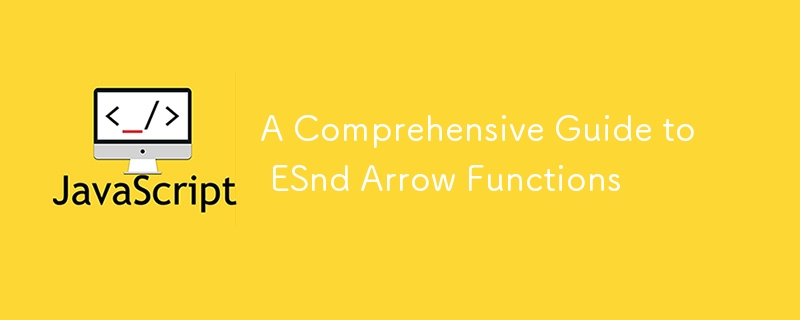ESnd 箭頭函數綜合指南

ES6简介
ECMAScript 2015,也称为 ES6 (ECMAScript 6),是对 JavaScript 的重大更新,引入了新的语法和功能,使编码更高效、更易于管理。 JavaScript 是用于 Web 开发的最流行的编程语言之一,ES6 的改进大大增强了其功能。
本指南将涵盖 ES6 中引入的重要功能,特别关注 箭头函数,一种强大的新函数编写方式。
ES6 的主要特性
1. let 和 const
ES6引入了两种新的变量声明方式:let和const。
-
let:声明块作用域变量,这意味着该变量仅在声明它的块内可用。
let x = 10; if (true) { let x = 2; console.log(x); // 2 (inside block) } console.log(x); // 10 (outside block) -
const:声明一个不能重新赋值的常量变量。然而,这并不会使变量不可变——使用 const 声明的对象仍然可以更改其属性。
const y = 10; y = 5; // Error: Assignment to constant variable. const person = { name: "John", age: 30 }; person.age = 31; // This is allowed.
2. 箭头函数
ES6 最受关注的功能之一是箭头函数。它为编写函数提供了更短、更简洁的语法。
#### 语法比较:
传统函数(ES5):
var add = function(x, y) {
return x y;
};
箭头函数 (ES6):
const add = (x, y) => x y;
箭头函数的不同之处如下:
- 更短的语法:不需要写function关键字,如果函数只有一条语句,可以省略大括号{}。
- 隐式返回:如果函数只包含一个表达式,则自动返回该表达式的结果。
- 没有 this 绑定:箭头函数没有自己的 this,使得它们不适合对象方法。
单线箭头函数示例:
const multiply = (a, b) => a * b; console.log(multiply(4, 5)); // 20
箭头函数也可以不带参数使用:
const greet = () => "Hello, World!"; console.log(greet()); // "Hello, World!"
对于多行函数,需要大括号{},并且返回语句必须显式:
const sum = (a, b) => {
let result = a b;
return result;
};
箭头函数和 this
一个重要的区别是箭头函数中的行为方式。与传统函数不同,箭头函数不绑定自己的 this — 它们从周围的上下文继承 this。
const person = {
name: "John",
sayName: function() {
setTimeout(() => {
console.log(this.name);
}, 1000);
}
};
person.sayName(); // "John"
在上面的示例中,setTimeout 中的箭头函数从 sayName 方法继承了 this,它正确引用了 person 对象。
3. 解构赋值
解构允许我们从数组或对象中提取值,并以更简洁的方式将它们分配给变量。
对象解构:
const person = { name: "John", age: 30 };
const { name, age } = person;
console.log(name); // "John"
console.log(age); // 30
数组解构:
const fruits = ["Apple", "Banana", "Orange"]; const [first, second] = fruits; console.log(first); // "Apple" console.log(second); // "Banana"
4. 展开和休息运算符 (...)
... 运算符可用于将数组展开为单个元素或将多个元素收集到一个数组中。
-
Spread:将数组扩展为单个元素。
const numbers = [1, 2, 3]; const newNumbers = [...numbers, 4, 5]; console.log(newNumbers); // [1, 2, 3, 4, 5]
-
Rest:将多个参数收集到一个数组中。
function sum(...args) { return args.reduce((acc, curr) => acc curr); } console.log(sum(1, 2, 3, 4)); // 10
5. 承诺
Promises 用于处理 JavaScript 中的异步操作。 Promise 代表了一个可能现在、将来或永远不可用的值。
例子:
const myPromise = new Promise((resolve, reject) => {
setTimeout(() => {
resolve("Success!");
}, 1000);
});
myPromise.then(result => {
console.log(result); // "Success!" after 1 second
});
在此示例中,promise 在 1 秒后解析,then() 方法处理解析后的值。
6. 默认参数
在ES6中,可以为函数参数设置默认值。当未提供或未定义参数时,这很有用。
例子:
function greet(name = "Guest") {
return `Hello, ${name}!`;
}
console.log(greet()); // "Hello, Guest!"
console.log(greet("John")); // "Hello, John!"
7. 字符串方法(包括()、startsWith()、endsWith())
新方法已添加到字符串中以使常见任务变得更容易:
-
includes():检查字符串是否包含指定值。
let str = "Hello world!"; console.log(str.includes("world")); // true -
startsWith():检查字符串是否以指定值开头。
console.log(str.startsWith("Hello")); // true -
endsWith():检查字符串是否以指定值结尾。
console.log(str.endsWith("!")); // true
8. 数组方法 (find(), findIndex(), from())
ES6 引入了处理数组的新方法:
-
find():返回第一个满足条件的元素。
const numbers = [5, 12, 8, 130, 44]; const found = numbers.find(num => num > 10); console.log(found); // 12
-
findIndex():返回第一个满足条件的元素的索引。
const index = numbers.findIndex(num => num > 10); console.log(index); // 1 (position of 12 in the array)
9. 课程
ES6 向 JavaScript 引入了类,它们是 JavaScript 现有的基于原型的继承的语法糖。类允许更清晰、更易于理解的面向对象编程。
例子:
class Car {
constructor(brand, year) {
this.brand = brand;
this.year = year;
}
displayInfo() {
return `${this.brand} from ${this.year}`;
}
}
const myCar = new Car("Toyota", 2020);
console.log(myCar.displayInfo()); // "Toyota from 2020"
结论
ES6 改变了 JavaScript,使其更高效、更易于使用。 箭头函数的引入简化了函数语法,而解构、promises、classes和扩展运算符等新功能 允许开发人员编写更清晰、更具表现力的代码。无论您是初学者还是高级开发人员,了解这些 ES6 功能对于编写现代 JavaScript 至关重要。
通过掌握这些概念,您将能够更好地应对现实世界的编码挑战并构建高效、可扩展的 Web 应用程序。
跟进 GitHub 上的 Arrow Functions 项目
参考
- https://www.w3schools.com/js/js_es6.asp
- https://towardsdatascience.com/javascript-es6-iterables-and-iterators-de18b54f4d4
- https://developer.mozilla.org/en-US/docs/Web/JavaScript/Reference/Functions/rest_parameters
- https://developer.mozilla.org/en-US/docs/Web/JavaScript/Reference/Functions/Default_parameters
- https://developer.mozilla.org/en-US/docs/Web/JavaScript/Reference/Functions/Arrow_functions
- https://developer.mozilla.org/en-US/docs/Web/JavaScript/Reference/Statements
-
 Java數組中元素位置查找技巧在Java數組中檢索元素的位置 利用Java的反射API將數組轉換為列表中,允許您使用indexof方法。 (primitives)(鏈接到Mishax的解決方案) 用於排序陣列的數組此方法此方法返回元素的索引,如果發現了元素的索引,或一個負值,指示應放置元素的插入點。程式設計 發佈於2025-07-07
Java數組中元素位置查找技巧在Java數組中檢索元素的位置 利用Java的反射API將數組轉換為列表中,允許您使用indexof方法。 (primitives)(鏈接到Mishax的解決方案) 用於排序陣列的數組此方法此方法返回元素的索引,如果發現了元素的索引,或一個負值,指示應放置元素的插入點。程式設計 發佈於2025-07-07 -
 為什麼PHP的DateTime :: Modify('+1個月')會產生意外的結果?使用php dateTime修改月份:發現預期的行為在使用PHP的DateTime類時,添加或減去幾個月可能並不總是會產生預期的結果。正如文檔所警告的那樣,“當心”這些操作的“不像看起來那樣直觀。 ; $ date->修改('1個月'); //前進1個月 echo $ date->...程式設計 發佈於2025-07-07
為什麼PHP的DateTime :: Modify('+1個月')會產生意外的結果?使用php dateTime修改月份:發現預期的行為在使用PHP的DateTime類時,添加或減去幾個月可能並不總是會產生預期的結果。正如文檔所警告的那樣,“當心”這些操作的“不像看起來那樣直觀。 ; $ date->修改('1個月'); //前進1個月 echo $ date->...程式設計 發佈於2025-07-07 -
 Spark DataFrame添加常量列的妙招在Spark Dataframe ,將常數列添加到Spark DataFrame,該列具有適用於所有行的任意值的Spark DataFrame,可以通過多種方式實現。使用文字值(SPARK 1.3)在嘗試提供直接值時,用於此問題時,旨在為此目的的column方法可能會導致錯誤。 df.withco...程式設計 發佈於2025-07-07
Spark DataFrame添加常量列的妙招在Spark Dataframe ,將常數列添加到Spark DataFrame,該列具有適用於所有行的任意值的Spark DataFrame,可以通過多種方式實現。使用文字值(SPARK 1.3)在嘗試提供直接值時,用於此問題時,旨在為此目的的column方法可能會導致錯誤。 df.withco...程式設計 發佈於2025-07-07 -
 如何使用Regex在PHP中有效地提取括號內的文本php:在括號內提取文本在處理括號內的文本時,找到最有效的解決方案是必不可少的。一種方法是利用PHP的字符串操作函數,如下所示: 作為替代 $ text ='忽略除此之外的一切(text)'; preg_match('#((。 &&& [Regex使用模式來搜索特...程式設計 發佈於2025-07-07
如何使用Regex在PHP中有效地提取括號內的文本php:在括號內提取文本在處理括號內的文本時,找到最有效的解決方案是必不可少的。一種方法是利用PHP的字符串操作函數,如下所示: 作為替代 $ text ='忽略除此之外的一切(text)'; preg_match('#((。 &&& [Regex使用模式來搜索特...程式設計 發佈於2025-07-07 -
 如何在鼠標單擊時編程選擇DIV中的所有文本?在鼠標上選擇div文本單擊帶有文本內容,用戶如何使用單個鼠標單擊單擊div中的整個文本?這允許用戶輕鬆拖放所選的文本或直接複製它。 在單個鼠標上單擊的div元素中選擇文本,您可以使用以下Javascript函數: function selecttext(canduterid){ if(d...程式設計 發佈於2025-07-07
如何在鼠標單擊時編程選擇DIV中的所有文本?在鼠標上選擇div文本單擊帶有文本內容,用戶如何使用單個鼠標單擊單擊div中的整個文本?這允許用戶輕鬆拖放所選的文本或直接複製它。 在單個鼠標上單擊的div元素中選擇文本,您可以使用以下Javascript函數: function selecttext(canduterid){ if(d...程式設計 發佈於2025-07-07 -
 為什麼在我的Linux服務器上安裝Archive_Zip後,我找不到“ class \” class \'ziparchive \'錯誤?class'ziparchive'在Linux Server上安裝Archive_zip時找不到錯誤 commant in lin ins in cland ins in lin.11 on a lin.1 in a lin.11錯誤:致命錯誤:在... cass中找不到類z...程式設計 發佈於2025-07-07
為什麼在我的Linux服務器上安裝Archive_Zip後,我找不到“ class \” class \'ziparchive \'錯誤?class'ziparchive'在Linux Server上安裝Archive_zip時找不到錯誤 commant in lin ins in cland ins in lin.11 on a lin.1 in a lin.11錯誤:致命錯誤:在... cass中找不到類z...程式設計 發佈於2025-07-07 -
 如何在其容器中為DIV創建平滑的左右CSS動畫?通用CSS動畫,用於左右運動 ,我們將探索創建一個通用的CSS動畫,以向左和右移動DIV,從而到達其容器的邊緣。該動畫可以應用於具有絕對定位的任何div,無論其未知長度如何。 問題:使用左直接導致瞬時消失 更加流暢的解決方案:混合轉換和左 [並實現平穩的,線性的運動,我們介紹了線性的轉換。...程式設計 發佈於2025-07-07
如何在其容器中為DIV創建平滑的左右CSS動畫?通用CSS動畫,用於左右運動 ,我們將探索創建一個通用的CSS動畫,以向左和右移動DIV,從而到達其容器的邊緣。該動畫可以應用於具有絕對定位的任何div,無論其未知長度如何。 問題:使用左直接導致瞬時消失 更加流暢的解決方案:混合轉換和左 [並實現平穩的,線性的運動,我們介紹了線性的轉換。...程式設計 發佈於2025-07-07 -
 如何使用Python的請求和假用戶代理繞過網站塊?如何使用Python的請求模擬瀏覽器行為,以及偽造的用戶代理提供了一個用戶 - 代理標頭一個有效方法是提供有效的用戶式header,以提供有效的用戶 - 設置,該標題可以通過browser和Acterner Systems the equestersystermery和操作系統。通過模仿像Chro...程式設計 發佈於2025-07-07
如何使用Python的請求和假用戶代理繞過網站塊?如何使用Python的請求模擬瀏覽器行為,以及偽造的用戶代理提供了一個用戶 - 代理標頭一個有效方法是提供有效的用戶式header,以提供有效的用戶 - 設置,該標題可以通過browser和Acterner Systems the equestersystermery和操作系統。通過模仿像Chro...程式設計 發佈於2025-07-07 -
 如何檢查對像是否具有Python中的特定屬性?方法來確定對象屬性存在尋求一種方法來驗證對像中特定屬性的存在。考慮以下示例,其中嘗試訪問不確定屬性會引起錯誤: >>> a = someClass() >>> A.property Trackback(最近的最新電話): 文件“ ”,第1行, attributeError:SomeClass實...程式設計 發佈於2025-07-07
如何檢查對像是否具有Python中的特定屬性?方法來確定對象屬性存在尋求一種方法來驗證對像中特定屬性的存在。考慮以下示例,其中嘗試訪問不確定屬性會引起錯誤: >>> a = someClass() >>> A.property Trackback(最近的最新電話): 文件“ ”,第1行, attributeError:SomeClass實...程式設計 發佈於2025-07-07 -
 如何在GO編譯器中自定義編譯優化?在GO編譯器中自定義編譯優化 GO中的默認編譯過程遵循特定的優化策略。 However, users may need to adjust these optimizations for specific requirements.Optimization Control in Go Compi...程式設計 發佈於2025-07-07
如何在GO編譯器中自定義編譯優化?在GO編譯器中自定義編譯優化 GO中的默認編譯過程遵循特定的優化策略。 However, users may need to adjust these optimizations for specific requirements.Optimization Control in Go Compi...程式設計 發佈於2025-07-07 -
 在Ubuntu/linux上安裝mysql-python時,如何修復\“ mysql_config \”錯誤?mysql-python安裝錯誤:“ mysql_config找不到”“ 由於缺少MySQL開發庫而出現此錯誤。解決此問題,建議在Ubuntu上使用該分發的存儲庫。使用以下命令安裝Python-MysqldB: sudo apt-get安裝python-mysqldb sudo pip in...程式設計 發佈於2025-07-07
在Ubuntu/linux上安裝mysql-python時,如何修復\“ mysql_config \”錯誤?mysql-python安裝錯誤:“ mysql_config找不到”“ 由於缺少MySQL開發庫而出現此錯誤。解決此問題,建議在Ubuntu上使用該分發的存儲庫。使用以下命令安裝Python-MysqldB: sudo apt-get安裝python-mysqldb sudo pip in...程式設計 發佈於2025-07-07 -
 C++中如何將獨占指針作為函數或構造函數參數傳遞?在構造函數和函數中將唯一的指數管理為參數 unique pointers( unique_ptr [2啟示。通過值: base(std :: simelor_ptr n) :next(std :: move(n)){} 此方法將唯一指針的所有權轉移到函數/對象。指針的內容被移至功能中,在操作...程式設計 發佈於2025-07-07
C++中如何將獨占指針作為函數或構造函數參數傳遞?在構造函數和函數中將唯一的指數管理為參數 unique pointers( unique_ptr [2啟示。通過值: base(std :: simelor_ptr n) :next(std :: move(n)){} 此方法將唯一指針的所有權轉移到函數/對象。指針的內容被移至功能中,在操作...程式設計 發佈於2025-07-07 -
 如何解決AppEngine中“無法猜測文件類型,使用application/octet-stream...”錯誤?appEngine靜態文件mime type override ,靜態文件處理程序有時可以覆蓋正確的mime類型,在錯誤消息中導致錯誤消息:“無法猜測mimeType for for file for file for [File]。 application/application/octet...程式設計 發佈於2025-07-07
如何解決AppEngine中“無法猜測文件類型,使用application/octet-stream...”錯誤?appEngine靜態文件mime type override ,靜態文件處理程序有時可以覆蓋正確的mime類型,在錯誤消息中導致錯誤消息:“無法猜測mimeType for for file for file for [File]。 application/application/octet...程式設計 發佈於2025-07-07 -
 為什麼HTML無法打印頁碼及解決方案無法在html頁面上打印頁碼? @page規則在@Media內部和外部都無濟於事。 HTML:Customization:@page { margin: 10%; @top-center { font-family: sans-serif; font-weight: ...程式設計 發佈於2025-07-07
為什麼HTML無法打印頁碼及解決方案無法在html頁面上打印頁碼? @page規則在@Media內部和外部都無濟於事。 HTML:Customization:@page { margin: 10%; @top-center { font-family: sans-serif; font-weight: ...程式設計 發佈於2025-07-07
學習中文
- 1 走路用中文怎麼說? 走路中文發音,走路中文學習
- 2 坐飛機用中文怎麼說? 坐飞机中文發音,坐飞机中文學習
- 3 坐火車用中文怎麼說? 坐火车中文發音,坐火车中文學習
- 4 坐車用中文怎麼說? 坐车中文發音,坐车中文學習
- 5 開車用中文怎麼說? 开车中文發音,开车中文學習
- 6 游泳用中文怎麼說? 游泳中文發音,游泳中文學習
- 7 騎自行車用中文怎麼說? 骑自行车中文發音,骑自行车中文學習
- 8 你好用中文怎麼說? 你好中文發音,你好中文學習
- 9 謝謝用中文怎麼說? 谢谢中文發音,谢谢中文學習
- 10 How to say goodbye in Chinese? 再见Chinese pronunciation, 再见Chinese learning

























